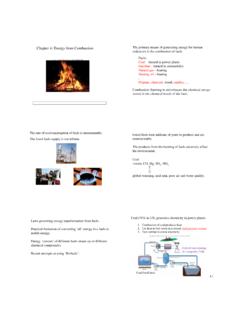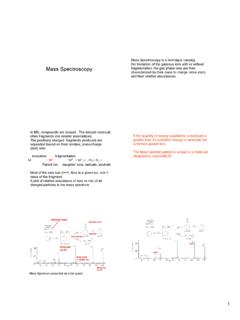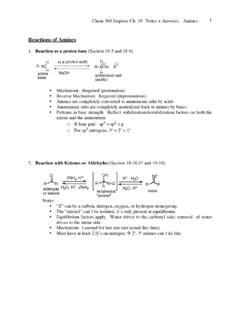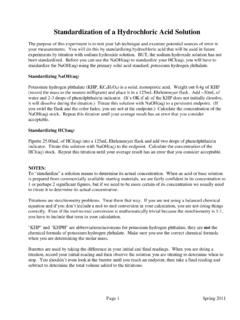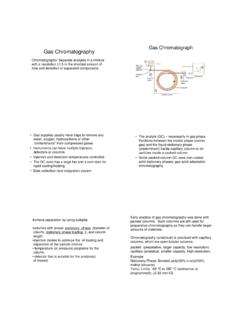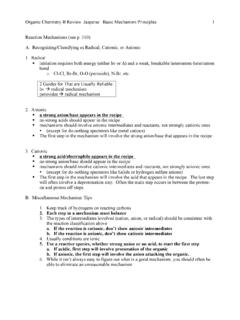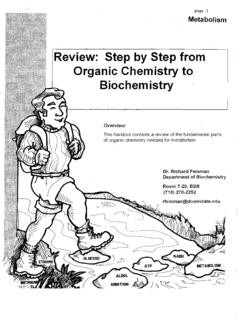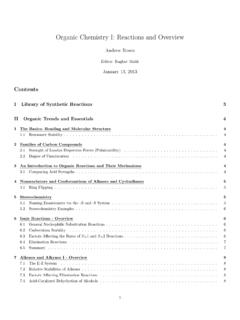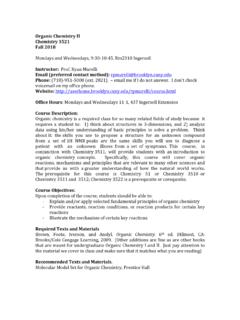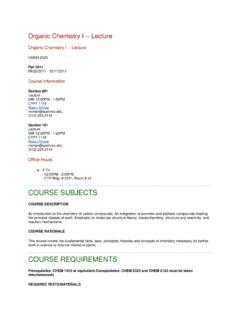Transcription of Some Arrow-Pushing Guidelines (Section 1.14)
1 organic chemistry I Review: Highlights of Key Reactions, Mechanisms, and Principles 1. some Arrow-Pushing Guidelines ( section ). 1. Arrows follow electron movement. 2. some rules for the appearance of arrows The arrow must begin from the electron source. There are two sources: a. An atom (which must have a lone pair to give). b. A bond pair (an old bond that breaks). An arrow must always point directly to an atom, because when electrons move, they always go to some new atom. 3. Ignore any Spectator Atoms.
2 Any metal atom is always a spectator . When you have a metal spectator atom, realize that the non-metal next to it must have negative charge 4. Draw all H's on any Atom Whose Bonding Changes 5. Draw all lone-pairs on any Atom whose bonding changes 6. KEY ON BOND CHANGES. Any two-electron bond that changes (either made or broken) must have an arrow to illustrate: where it came from (new bond made) or an arrow showing where it goes to (old bond broken). 7. Watch for Formal Charges and Changes in Formal Charge If an atom's charge gets more positive it's donating/losing an electron pair arrow must emanate from that atom or one of it's associated bonds.
3 There are two more positive transactions: When an anion becomes neutral. In this case, an arrow will emanate from the atom. The atom has donated a lone pair which becomes a bond pair. When a neutral atom becomes cationic. In this case, the atom will be losing a bond pair, so the arrow should emanate from the bond rather than from the atom. If an atom's charge gets more negative it's accepting an electron pair an arrow must point to that atom. Ordinarily the arrow will have started from a bond and will point to the atom.
4 8. When bonds change, but Formal Charge Doesn't Change, A Substitution is Involved Often an atom gives up an old bond and replaces it with a new bond. This is substitution . In this case, there will be an incoming arrow pointing directly at the atom (to illustrate formation of the new bond), and an outgoing arrow emanating from the old bond that breaks organic chemistry I Review: Highlights of Key Reactions, Mechanisms, and Principles 2. Reactive Intermediates: Stability Patterns Shortlived, unstable, highly reactive intermediates Normally lack normal bonding These are tremendously important: 1.
5 They will be the least stable intermediate in any multistep mechanism 2. When formed, they are products of the rate-determining step 3. Factors that stabilize them will speed up reaction rates Thus it is very important to know their stability patterns! Class Structure Stability Pattern Carbocations Allylic > 3 > 2 > 1 > methyl > alkenyl Electron Electrophilic/. C. (vinyl, aryl) Poor Acidic Carbon Allylic > 3 > 2 > 1 > methyl > alkenyl Electron Electrophilic/. C. Radicals (vinyl, aryl) Poor Acidic Carbanions Allylic > alkenyl (vinyl, aryl) > methyl > 1 > Electron Nucleophilic/.
6 C 2 > 3 Rich Basic Notes 1. Both carbocations and radicals have the same pattern. So you don't need to memorize them twice! 2. Carbanions are almost exactly the reverse, except that being allylic is ideal for both. 3. All benefit from resonance (allylic). 4. Cations and radicals both fall short of octet rule. As a result, they are both electron deficient. Carbanions, by contrast, are electron rich. 5. Alkyl substituents are electron donors. As a result, they are good for electron deficient cations and radicals (3 > 2 > 1 > methyl) but bad for carbanions.
7 6. Alkenyl (vinyl or aryl) carbons are inherently a bit electron poor. This is excellent for carbanions, but terrible for cations or radicals. organic chemistry I Review: Highlights of Key Reactions, Mechanisms, and Principles 3. Stability/Reactivity/Selectivity Principles 1. Reactant Stability/Reactivity: The more stable the reactant, the less reactive it will be. In terms of rates, this means that the more stable the reactant, the slower it will react. (The concept here is that the more stable the reactant, the more content it is to stay as is, and the less motivated it is to react and change into something different).
8 Key note: Often the reactant that's relevant in this context will not be the original reactant of the reaction, but will be the reactant involved in the rate determining step. Basicity O. CH2 Na > NHNa > ONa >. ONa A B C D. Why: As anion stability increases from A to D, the reactivity decreases Nucleophilicity O. CH2 Na > NHNa > ONa >. ONa A B C D. Why: As anion stability increases from A to D, the reactivity decreases Nucleophilicity O. SeNa > SNa > >. ONa ONa A B C D. Why: As anion stability increases from A to D, the reactivity decreases Reactivity toward alkanes via radical halogenation F2 > Cl2 > Br2 > I2 because F > Cl > Br > I.
9 Why: Chlorine is more reactive the bromine because chlorine radical is less stable then bromine radical. Electrophilicity (Reactivity in SN2, SN1, E2, E1 Reactions). I > Br > Cl Why: As carbon-halogen bond stability increases, the reactivity decreases organic chemistry I Review: Highlights of Key Reactions, Mechanisms, and Principles 4. 2. Product Stability/Reactivity: The more stable the product, the more favorable its formation will be. In terms of rates, this means that the more stable the product, the faster the reaction.
10 (The concept here is that the more stable the product, the more favorable it will be to make that product.). Key note: Often the product that's relevant in this context will not be the final product of the reaction, but will be the product of the rate determining step. Acidity O. CH3 < NH2 < OH <. OH. Why: Because as the stability of the anion products increases from A to D, the reactivity of the parent acids increase O. CH2 Na < NHNa < ONa <. ONa A B C D. Reactivity of alkanes toward radical halogenation CH3 < < <.

